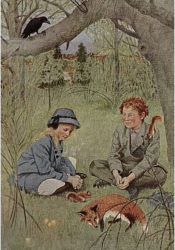"The Secret Garden" by Frances Hodgson Burnett
The Secret Garden, written by Frances Hodgson Burnett and published in 1911, is the story of a disagreeable little girl, Mary, who goes to live with her estranged uncle after her parents die. She discovers an overgrown garden on the estate, and in the process of caring for it, gains a better attitude on life, and helps others around her overcome their own misery and depression. The book focuses on mentality and the mental state of the characters, and uses surroundings to help illustrate. The giant estate of Mary’s uncle Archie Craven at first serves as an atmosphere of loneliness, with many rooms either vacant or closed off, and Mary being confined to two rooms. Each character "is trapped in [their] own misery and brings misery to everyone else” (Thomas par. 16). Much like how gothic literature uses strong physical imagery of haunting grandeur to set the mood, The Secret Garden uses the giant estate set in Yorkshire by a moor to anchor emotions and mindsets of character. All the characters are made to realize that they take part in letting their own misery flourish. In order to get out of this hopeless mindset, “Each person is first challenged to question assumptions about her- or himself and the world. This leads to trying new behaviours and new emotions”(Thomas par. 18). Though the novel has some aspects that resemble certain qualities of Wuthering Heights by Emily Brontë, like the physical embodiment of mood through setting and themes of mental health, the novel also focuses on the characters recognizing negative thought patterns and working to overcome them rather than succumb to them.
Thomas, Trudelle H. “The Joy-Maker in the Garden: Cognitive Behavioural Therapy InThe Secret Garden(1911).” International Journal of Children's Spirituality, vol. 21, no. 2, 2016, pp. 128–139., doi:10.1080/1364436x.2016.1182895.

